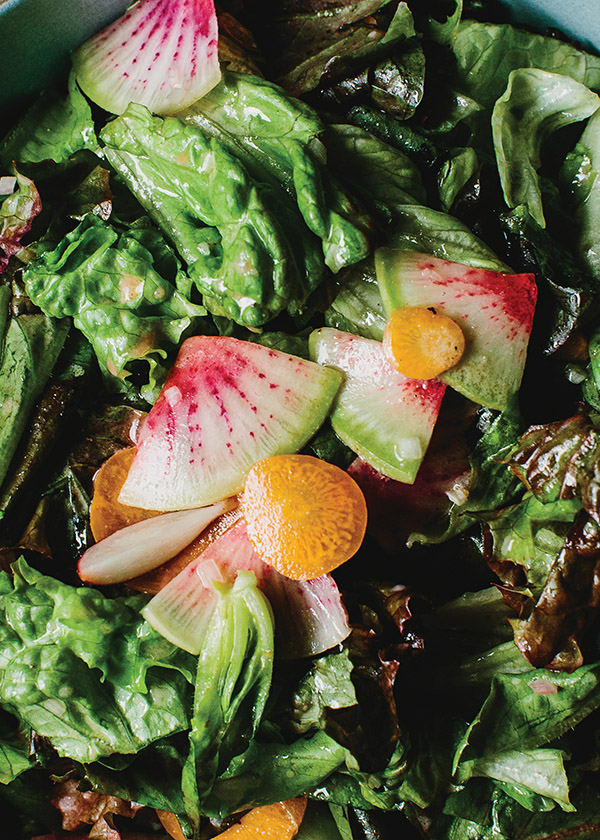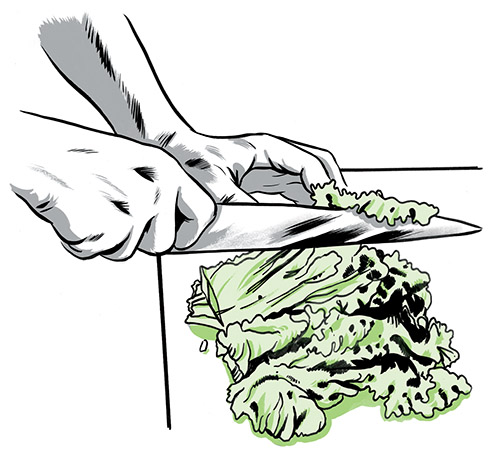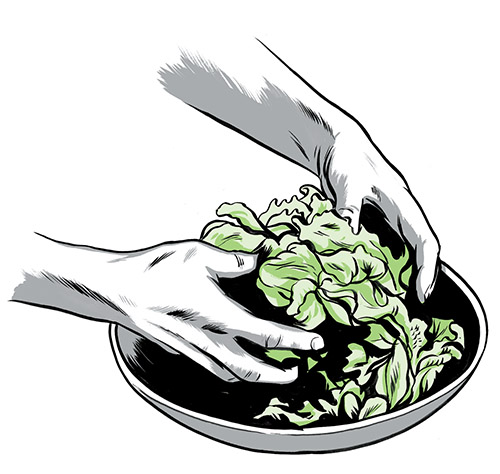
“Everyone thinks salad-making is so friggin’ easy,” says Steven Satterfield. “But there’s a lot more nuance to it than people realize.” How you choose, wash, dry, store, dress, and toss those leaves can mean the difference between a salad that dazzles and one that disappoints. Spring is the perfect time to prove his point, when local lettuces sold at area farmers markets are at their most pristine and plentiful. Grown with care in moderate temperatures, he says, these tender spring leaves are “sweet, crunchy, light, and mild—the perfect base for a well-made salad.” Satterfield stores his greens by wrapping the leaves in a damp paper towel before placing them inside a plastic bag that’s partially sealed. This helps prevent the refrigerator’s dry air from wilting the leaves while still allowing them to breathe.
For extra flavor, he likes to add fresh herbs like tarragon, parsley, basil, or chervil before dressing the leaves. (He advises finely chopping heartier herbs like rosemary, thyme, or oregano and adding them to the dressing.) Color and crunch come from paper-thin shavings of radishes, carrots, or other root vegetables, but rarely tomatoes—by the time they’re in season, most of the spring lettuces are gone.
The breakdown
 1. Cut out core and trim away any bruised leaves. Slice remaining leaves into uniform, bite-sized pieces before washing; larger leaves can trap dirt.
1. Cut out core and trim away any bruised leaves. Slice remaining leaves into uniform, bite-sized pieces before washing; larger leaves can trap dirt.
 2. Submerge lettuce in a large container filled with enough water for the leaves to move around freely as you agitate them with your hands, allowing dirt to fall to the bottom.
2. Submerge lettuce in a large container filled with enough water for the leaves to move around freely as you agitate them with your hands, allowing dirt to fall to the bottom.
 3. Transfer clean leaves to a salad spinner, discarding dirty water. Spin until completely dry (the dressing will cling better). No spinner? Put lettuce in a linen bag and shake.
3. Transfer clean leaves to a salad spinner, discarding dirty water. Spin until completely dry (the dressing will cling better). No spinner? Put lettuce in a linen bag and shake.
 4. Place washed and dried lettuce in a deep, wide bowl. Spoon a thin film of dressing around the sides of the bowl, distributing with the back of a spoon.
4. Place washed and dried lettuce in a deep, wide bowl. Spoon a thin film of dressing around the sides of the bowl, distributing with the back of a spoon.
 5. With fingers spread apart, gently lift lettuce upward from the bottom, allowing your fingers to graze the inside of the bowl. Repeat until leaves are evenly coated.
5. With fingers spread apart, gently lift lettuce upward from the bottom, allowing your fingers to graze the inside of the bowl. Repeat until leaves are evenly coated.
Give It a Whirl
Satterfield is partial to salad spinners with an easy-to-use pump on top. Oxo (which consistently gets top scores from “Cook’s Illustrated”) makes one with a lifetime guarantee that’s dishwasher-safe with a non-slip base. The inside container can double as a colander and the exterior as a serving bowl. amazon.com
Bonus recipe: Shallot vinaigrette
Satterfield keeps his cabinets well stocked with a variety of oils and vinegars for mixing and matching, although one of his favorites is this tangy shallot vinaigrette: In a medium bowl, combine 3 Tbsp finely diced shallots, 1 Tbsp Dijon mustard, 1 tsp kosher salt, a few grindings of black pepper, and 2 Tbsp each apple cider vinegar and sherry vinegar. Slowly drizzle in 3/4 cup extra virgin olive oil and whisk quickly to emulsify. Taste for seasoning (makes 1 cup).
Bonus recipe: Buttermilk Dressing
1 teaspoon minced fresh green garlic, when in season (use mature garlic if not available)
1 tablespoon Champagne vinegar
1 teaspoon kosher salt
1/2 teaspoon freshly ground black pepper
1 cup Homemade Mayonnaise (instructions follow)
1/2 cup buttermilk
1 tablespoon finely sliced chives
In a medium bowl, combine the garlic, vinegar, salt, and pepper. Whisk in the mayonnaise, buttermilk, and chives. Taste for seasoning and adjust as needed. Transfer dressing to a storage container, cover, and refrigerate until ready to use.
To make about 2 cups homemade mayonnaise: In a food processor, combine 1 whole egg, 1 egg yolk, 1 teaspoon dry mustard, 1 tablespoon fresh lemon juice, 1 tablespoon apple cider vinegar, and 1 teaspoon fine sea salt. With the motor running, slowly drizzle in 1 1/2 cups canola oil. When emulsified, transfer to a storage container, cover, and refrigerate for up to 2 weeks.
Lightly adapted from “Root To Leaf” by Steven Satterfield
Makes about 1 ½ cups
 Steven Satterfield
Steven Satterfield
While cooking at two of Atlanta’s first farm-to-table restaurants, Floataway Cafe and Watershed, Satterfield developed a knack for coaxing maximum flavor out of seasonal produce. He’s since become known for stunning vegetable plates and salads at Miller Union, which he opened with business partner Neal McCarthy in 2009. In March, he debuted his first cookbook, “Root to Leaf.”
Illustrations by Joel Kimmel
This article originally appeared in our May 2015 issue.













